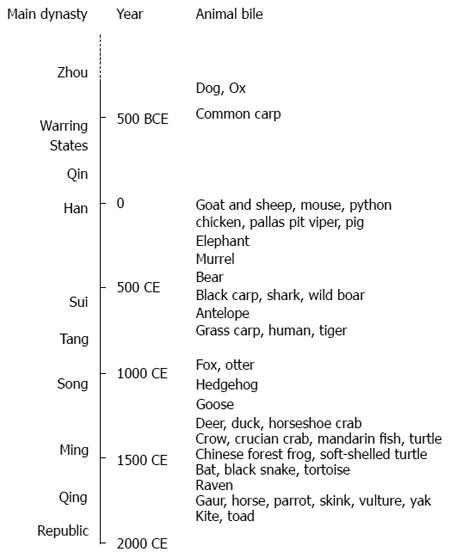Copyright
©2014 Baishideng Publishing Group Inc.
World J Gastroenterol. Aug 7, 2014; 20(29): 9952-9975
Published online Aug 7, 2014. doi: 10.3748/wjg.v20.i29.9952
Published online Aug 7, 2014. doi: 10.3748/wjg.v20.i29.9952
Figure 1 Perspective structures of major bile acids in selected animal biles according to groups of organisms: mammals (humans, bears, pigs and mice); birds;reptiles (snakes and turtles); amphibians (toads and frogs); and fish.
The C24 common bile acids of higher vertebrates possess a steroid nucleus of four fused hydrocarbon rings with a cis A/B ring junction, but the biles of amphibians and fish contain C24 or C27 bile acids with trans A/B ring junctions. The polar hydroxyl functions generally are α-axial or equatorial and an aliphatic side chain is conjugated with glycine or taurine in C24 bile acids or sulfated in C27 bile acids. Because the ionized carboxylate, sulfonate or sulfate groups on the side chain render bile salts highly soluble in water, they are classified as soluble amphiphiles. The common bile acids differ in the number and orientation of the hydroxyl groups on the steroid nucleus. In humans, ursodeoxycholic acid is a secondary bile acid; whereas in a number of animals especially hystricomorpha and all ursidae, it is a primary bile acid i.e., made directly from cholesterol in the liver. Reproduced with modifications and with permission from[165].
Figure 2 Chronology for the introduction of different animal biles used therapeutically in traditional Chinese medicine.
The main Chinese dynasties are listed to the left of year in 500-year increments to indicate the approximate beginning of the dynasty. BCE: Before the common era; CE: Common era which corresponds to the common Gregorian calendar.
Figure 3 Four pages from Li Shi-Zhen’s Compendium of Materia Medica (Ben Cao Gang Mu) published in 1596 CE in the Ming Dynasty.
A: Goat (top left), pig (top right), Procapra przewalskii (Przewalskii’s gazelle) (bottom left) and dog (bottom right); B: Crow (top left) and raven (bottom right); C: Python (top right) and black snake (bottom left); D: Common carp (top right). The biles of these animals were introduced into traditional Chinese medicine as important drugs to treat various diseases as discussed in the text.
Figure 4 Three woodcuts from Pictures of the Famous Products of Mountain and Sea (Sankai Meizan Zue) illustrated by Shitomi Kangetsu (1747 to 1797 CE) and published in 1799 CE, showing how to catch a bear and harvest bear bile.
Capturing a bear in a cave (top panel). Seizing a bear by killing with a heavy crossbow (middle panel). Killing a bear with an axe (bottom panel).
Figure 5 When human, domestic pig, or wild boar gallbladder biles, all with high phospholipid to bile acid ratios, are diluted progressively with low concentrations of alcohol such as with wine, the bile acid concentration decreases below its critical micellar concentration in the bile, and the specimen becomes cloudy from phase separation of previously micellar solubilized phospholipids plus cholesterol.
This occurs because liquid crystals (lamellar liposomes) composed of phospholipids and cholesterol form spontaneously in the dilute non-micellar bile and also have potent antioxidant properties from bound bilirubin conjugate molecules. Such preparations were employed as an artificial skin and were used widely in China to dress and cover burns and battle wounds. See text for details.
- Citation: Wang DQH, Carey MC. Therapeutic uses of animal biles in traditional Chinese medicine: An ethnopharmacological, biophysical chemical and medicinal review. World J Gastroenterol 2014; 20(29): 9952-9975
- URL: https://www.wjgnet.com/1007-9327/full/v20/i29/9952.htm
- DOI: https://dx.doi.org/10.3748/wjg.v20.i29.9952

















